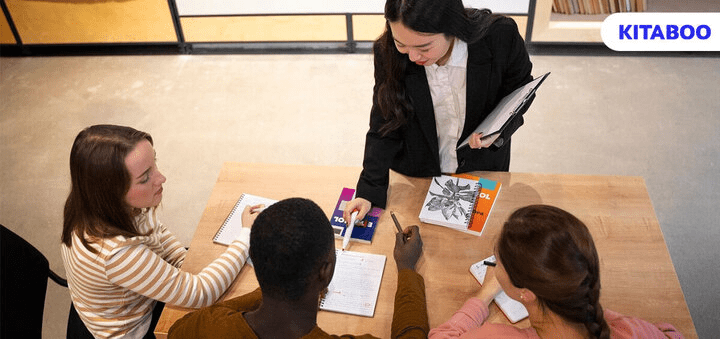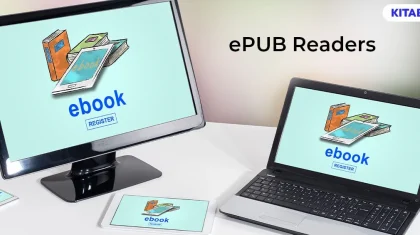
6 Key Differentiated Instruction Strategies For a Diversity-Inclusive Classroom
Summarize this blog with your favorite AI:
Learning is a capability, and it is intrinsically ingrained in every human. Some people learn better through experiences, and others learn better through reading. In classrooms as well, every student has different capabilities and capacities for learning.
Creating an inclusive environment in classrooms with students who have diverse learning needs is a complicated task. It involves giving consideration to the learning needs of each individual student and tailoring the curriculum in a way that allows everyone to stay on the same page while learning.
In this blog, you will glean about the six key strategies that can help you create an instruction plan for a diverse learning pool.
Table of Contents
I. What is Differentiated Instruction?
II. The Top 6 Differentiated Instruction Strategies
III. DE&I With KITABOO
What is Differentiated Instruction?
Differentiated instruction is a pedagogical approach that involves tailoring the teaching content to suit every learner’s specific needs. It consists of modifying the content, the delivery process, and the ultimate products so that learning outcomes are better for everyone.
Differentiated instruction includes the following aspects:
- Tailoring the teaching content according to the needs, preferences, strengths and struggles of the students
- Employing one-on-one teaching for students
- Enabling learning flexibility for students
Differentiated instruction is different from personalized learning in several ways. Personalized learning gives students more control over their lessons.
On the other hand, differentiated instruction is more of a pedagogical approach towards enhancing curriculum accessibility and relevance for all learners in a classroom.
Let’s now look at the 6 key differentiated instruction strategies you can readily apply in your classroom.
The Top 6 Differentiated Instruction Strategies
Catering to the needs of every single student in a classroom can be a tricky task to manage. Still, with the 6 differentiated instruction strategies listed below, it can be managed effectively.
1. Learning Stations
Setting up learning stations in classrooms can help students get access to learning content delivered in different ways. Each station could be designed to deliver a lesson differently, catering to the needs of the students who require differentiated instruction.
The students can then be divided into groups and made to go through each learning station as a part of the curriculum. Doing this helps expose each student to unique lesson delivery at each learning station, addressing the gaps for those who require a different method.
Some examples of differentiated learning stations are:
- Watching a video
- Engaging in hands-on activity
- Lecture-based learning
- Reading and learning through stories
2. Student Interviews
There is no better way of providing differentiated instruction than by knowing firsthand from the students about their experiences. Educators can take some time after class to speak individually with each student to ask them how the lesson delivery can be improved for better learning.
Student feedback helps teachers understand which lessons students find interesting, which activities create the best and least engagement, the projects that students did well and the ones they lagged in, etc.
This data can be further leveraged to design a curriculum that is differentiated enough for each student to glean from it effectively.
3. Create Awareness
The idea of differentiated learning needs to be embraced by the students before teachers can implement it successfully in the classroom. Talk to the students about diversity and inclusion, about how each individual has their own learning needs.
Teachers can demonstrate through their own examples and experiences in learning about the importance of understanding learning preferences. Creating awareness around the fact that people process information differently can help streamline the downstream process of implementing differentiated learning strategies more effectively.
You can circulate a questionnaire that students can fill out with answers to questions like:
- Which learning methods help them learn most effectively?
- Which learning media do they interact with the most?
4. Think-Pair-Share
This three-pronged activity targets different areas of student skill in a single activity. Teachers can implement this by raising a query in the classroom and encouraging the students to use their critical thinking to arrive at a solution.
In the next phase, the teacher can pair up two students to discuss their solutions with each other and finetune the outcome. In the final phase, the teacher can then request the students to share their ideas with the entire class.
This method incorporates individual thinking, shared learning, and interpersonal interactions into one activity, making differentiated instruction more effective for the learners.
5. Free Study
Free study time is especially beneficial for students who prefer to learn individually. However, to cater to a diverse pool of learners, teachers can modify it according to their preferences.
For example, the teacher can announce a free study lesson and ask which students would prefer to form groups to solve a problem and which students would prefer to do it by themselves.
There are several resources available to teachers for achieving this differentiated instruction strategy, like audiobooks, learning stations, notes and gamified modules.
Teachers can leverage digital publishing platforms like KITABOO to create dedicated differentiated instruction materials for implementation and distribution in classrooms.
6. Similarity Groups
One effective way of implementing differentiated learning in the classroom is to segment students together based on their learning preferences. Those who require teachers’ assistance can be grouped into one segment, while those who prefer watching videos can be grouped together.
Teachers can form their own criteria depending on the learning preferences discovered in the classroom. This helps club the like-minded students together, which in turn works as a boost for each of them to learn from one another.
It also allows the teachers to address the common needs of a group of students in a simplified, manageable way.
DE&I With KITABOO
Diversity in the classroom is inevitable. You will have students who take little to no effort in progress and students who require a helping hand and guidance to go the right way. There will be learners who prefer eBooks to lectures and others who find it easier to learn through experiences.
To ensure that your lessons are equally effective for all learners, you need to design your curriculum with the differentiated instruction strategies mentioned in this blog. Leverage the publishing prowess of KITABOO, the digital textbook platform to create highly interactive, engaging, and differentiated instruction materials that provide several lesson delivery options to suit everyone’s needs.
To know more about how KITABOO can improve differentiated instruction, visit the website.
Discover how a mobile-first training platform can help your organization.
KITABOO is a cloud-based platform to create, deliver & track mobile-first interactive training content.


